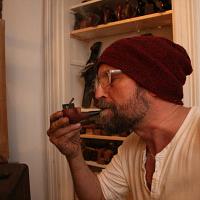
MaFe
in over 11 years
Bench slave - board Jack, dead man.
Bench slave
board Jack, dead man.
From time to time we could all need a helper, but luckily the slavery is over, so we will go for a dead man naaaaa that’s too morbid, well a board Jack then, somehow that must be the most political correct name these days, but I do like the sound of a bench slave, its kind of a mix between pirates and SM, laughs.
I got tired of putting stuff under my boards when planing, so it was time to look into history, to make my self a helper.
I actually made a bench slave before, but it was made only for long boards and used the tail vice to hold it, so it was not movable, finally it was a wee flimsy and I wanted something solid.
Here you have it, the bench slave supporting the board back end, front end is held in the shoulder vice.
Once again some recycle, local carpenters had thrown some construction timber in the street, I picked it up and ran it over the table saw.
Its roughly 5×5cm / 2×2inch.
After a blade change, I could cut some to length, so we can make the foot.
Making a quick and clean lap joint by making repetitive cuts on the table saw.
Perfect fit by eye.
Do you feel lucky punk…
Drilling a hole through it all, a size smaller than the tenon I want.
Chisel out the rest, go slow, enjoy the process.
Clean up sides by paring and make the bottom a wee bigger than the top, app 1mm on all sides.
I just love to work here, with some good music, today Callas La Boheme and of course razor sharp chisel, that are regularly stropped.
To make the through tenon, I measure the hole I made and again make a series of repetitive cuts, then clean up with a shoulder plane.
Drill through from both sides.
Saw to the hole.
This will make the wood avoid splitting any further when wedging.
Now push the pole in, it should be a tight fit..
So here you see it from the bottom, as you can see the sides are loose, due to the fact we made the bottom of the mortise bigger.
Just for joy, the sides are getting a saw cut, also you are less likely to fall over them.
Small blocks are cut.
Glued on to the bottom.
With historical correct brat nails
Cleaning it up, chamfering the edges.
Now the pole are cleaned up and chamfered.
Next up I drilled holes and here chamfering the edges.
I had some beech rod laying in the shop, so this were planed and sanded to fit the holes tight.
Drilling a hole in the beech stops / rods.
Rounding them over.
Hardwood wedges are made.
Time to glue up the ChristMadstree.
Kept under tension for app an hour.
The pole can get some glue.
Foot on pole and wedge hammered in.
Wedges hammered in, notice I made them so big, that they also go into the food a wee bit for strength.
Cleaned up.
Here we have it!
A slave or Jack, but I dont think it looks dead
Branding for the joy of it.
The pegs get a leather string, for joy and to make it easier to pull them out.
Finally we can start some planing and I love it.
One of those projects we should make on the day we buy the bench, not ten years after
Better late than never, so Im a happy monkey now.
Hope it can be to some inspiration, or just a support.
Best thoughts,
MaFe
MaFe vintage architect and fanatical rhykenologist.
2 Comments
Losing fingers since 1969
Big smile, I am more and more leaving tools and jigs, rough and without finish. I have come to like the patina and that tools are made for use and abuse. But I agree shellac is kind of only right in amber, smiles. If I should do something to this one, it would be a dye and then an oil finish as I did with the workbench many years back (the bench were in such terrible state, that I had to).
I'll thank you now for the comment. ;-)
MaFe vintage architect and fanatical rhykenologist.









































